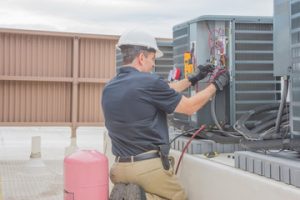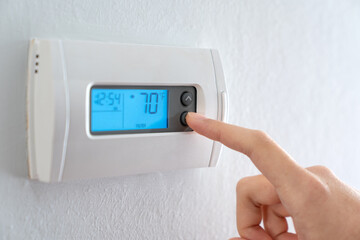Heating, ventilation, and air conditioning (HVAC) systems are essential for maintaining comfort, health, and energy efficiency in both residential and commercial spaces. From regulating temperature and controlling humidity to filtering air and promoting proper ventilation, HVAC systems play a critical role in ensuring indoor environments remain safe and comfortable year-round. However, these complex systems require professional expertise for proper installation, timely repair, and regular maintenance.
Expert HVAC Round Rock services ensure systems operate efficiently, extend their lifespan, improve indoor air quality, and prevent costly breakdowns. This comprehensive guide highlights the importance of professional HVAC services, common system challenges, preventive maintenance, and the benefits of expert care.

The Importance of Expert HVAC Services
HVAC systems are intricate networks of components, including furnaces or boilers, air conditioners, heat pumps, ductwork, thermostats, and filtration systems. Each component must work seamlessly to provide consistent heating, cooling, and ventilation. When one part of the system fails or functions inefficiently, it can lead to discomfort, higher energy bills, and potential damage to other components.
Expert HVAC services are essential because they provide accurate diagnostics, professional repairs, and optimized system performance. Skilled technicians have the knowledge and tools to identify problems quickly, perform precise repairs, and recommend upgrades or preventive maintenance strategies. By addressing HVAC issues promptly and professionally, homeowners and businesses can maintain consistent indoor comfort while reducing energy costs and extending the lifespan of their systems.
For residential properties, professional HVAC services ensure that living spaces remain comfortable and healthy throughout the year. For commercial spaces, reliable HVAC performance is critical for productivity, customer satisfaction, and maintaining a safe and regulated environment.
HVAC Installation Services
Proper installation is the foundation of an efficient and reliable HVAC system. Expert HVAC services provide professional installation for new systems or replacements.
- System Assessment: Technicians evaluate the property size, insulation, layout, and specific needs to recommend the right system capacity and type. Proper sizing prevents issues such as short cycling, inadequate cooling, or excessive energy consumption.
- Equipment Selection: Expert installers help homeowners and business owners choose high-efficiency units, energy-saving components, and systems that meet their comfort and budget requirements.
- Professional Installation: Proper installation ensures optimal performance, reduces the risk of future breakdowns, and enhances energy efficiency. Expert HVAC technicians follow manufacturer guidelines and industry best practices to ensure all components, including ductwork and thermostats, are installed correctly.
- Zoning and Controls: Many installations incorporate zoning systems and smart thermostats for precise temperature control in different areas. This improves comfort, reduces energy waste, and allows users to manage their HVAC system remotely.
A professionally installed system provides consistent comfort, improves energy efficiency, and minimizes the need for early repairs or replacements.
HVAC Repair Services
Even the most reliable HVAC systems can experience issues over time. Expert HVAC services provide fast and effective repair solutions for a wide range of problems, helping prevent prolonged discomfort and costly system failures.
- Inconsistent Heating or Cooling
- Uneven temperatures or hot and cold spots may result from airflow issues, thermostat malfunctions, or blocked ductwork. Technicians diagnose the root cause and restore balanced heating or cooling throughout the property.
- Dirty or Clogged Filters
- Filters trap dust, pollen, and other particles, preventing them from circulating indoors. Over time, filters become clogged, restricting airflow and reducing efficiency. Professionals replace or clean filters to restore proper airflow and system performance.
- Refrigerant Issues
- Air conditioners rely on refrigerant for cooling. Low levels due to leaks reduce cooling capacity and strain the compressor. HVAC experts locate leaks, repair affected components, and recharge refrigerant to optimal levels.
- Electrical Failures
- Faulty wiring, blown fuses, or malfunctioning capacitors can cause system interruptions or complete failures. Skilled technicians safely repair electrical components to restore reliable operation.
- Unusual Noises and Odors
- Buzzing, rattling, or grinding sounds often indicate mechanical or electrical problems, while musty or chemical odors can signify mold, debris, or refrigerant leaks. Professionals identify the source and perform necessary repairs or cleaning.
- Water Leaks or Ice Formation
- Condensation leaks or ice buildup on coils can indicate airflow problems or drainage issues. Technicians correct these issues to prevent damage and maintain proper system function.
Timely repairs performed by expert HVAC technicians improve system efficiency, restore indoor comfort, and prevent long-term damage.
Preventive HVAC Maintenance
Regular maintenance is crucial for maximizing the efficiency, longevity, and reliability of HVAC systems. Preventive maintenance identifies minor issues before they escalate into major problems and ensures that equipment operates at peak performance. Key maintenance tasks include:
- Filter Cleaning or Replacement: Maintaining clean filters improves airflow, reduces energy consumption, and enhances indoor air quality.
- Coil Cleaning: Dirt accumulation on evaporator and condenser coils reduces heat transfer efficiency. Cleaning coils restores optimal performance.
- Refrigerant Checks: Proper refrigerant levels are essential for efficient cooling and compressor protection.
- Electrical Inspections: Technicians check wiring, capacitors, and connections to prevent electrical failures and ensure safe operation.
- Ductwork Evaluation: Sealing leaks, insulating ducts, and optimizing airflow maintain balanced temperatures and reduce energy waste.
Many HVAC providers offer seasonal maintenance plans to schedule inspections before peak heating or cooling periods. Regular maintenance reduces emergency repairs, improves energy efficiency, and ensures consistent indoor comfort throughout the year.
Energy Efficiency Benefits
Expert HVAC services not only restore system functionality but also optimize energy performance. Properly maintained and repaired systems consume less energy while delivering consistent comfort. Energy efficiency benefits include:
- Reduced Utility Bills: Fixing leaks, cleaning coils, and optimizing airflow reduces energy consumption and costs.
- Enhanced Equipment Lifespan: Efficient systems experience less strain on components, prolonging their operational life.
- Environmental Impact: Lower energy usage reduces the carbon footprint of homes and commercial properties.
- Smart Thermostat Integration: Programmable and smart thermostats optimize system operation based on occupancy, schedules, or environmental conditions, further improving energy efficiency.
By investing in expert HVAC services, property owners can enjoy both improved comfort and cost savings.
Improving Indoor Air Quality
HVAC systems play a vital role in maintaining healthy indoor air. Expert services improve air quality through:
- Advanced Filtration: High-quality filters capture fine particles, allergens, and dust, keeping the air clean.
- Humidity Control: Proper humidity levels prevent mold growth, reduce allergens, and enhance comfort.
- Air Purification: UV lights, ionizers, and HEPA filters remove contaminants and improve overall air quality.
Improving indoor air quality not only benefits occupant health but also supports system efficiency and longevity.
Residential vs. Commercial HVAC Services
Residential HVAC Services
Homeowners benefit from expert HVAC services through reliable heating and cooling, improved indoor air quality, and reduced energy consumption. Regular maintenance, timely repairs, and system upgrades ensure comfort and efficiency throughout the year.
Commercial HVAC Services
Businesses require dependable HVAC systems to maintain employee productivity, protect equipment, and provide a comfortable environment for clients. Professional commercial services include system design, repair, preventive maintenance, and energy efficiency upgrades to support large or complex spaces.
Both residential and commercial properties gain from expert HVAC services that ensure system reliability, energy efficiency, and year-round comfort.
Signs You Need Professional HVAC Services
Property owners should look out for indicators that HVAC installation, repair, or maintenance is required:
- Uneven or inconsistent temperatures
- Unusual noises or odors from the system
- Water leaks or ice buildup
- Frequent cycling or short-cycling of the system
- Rising energy bills despite normal usage
- Poor indoor air quality or lingering allergens
Prompt attention to these signs prevents minor issues from escalating, protecting the system and maintaining comfort.
Choosing a Reliable HVAC Service Provider
Selecting the right HVAC service provider is crucial for optimal performance and peace of mind. Key considerations include:
- Experience and Expertise: Technicians should be knowledgeable across various HVAC systems and brands.
- Comprehensive Services: Providers should offer installation, repair, maintenance, and upgrade options.
- Quick Response Times: Fast service is essential, especially during extreme weather conditions.
- High-Quality Parts: Using quality components ensures long-lasting repairs and system reliability.
- Maintenance Plans: Scheduled preventive maintenance reduces future repair needs and enhances energy efficiency.
A trusted provider delivers consistent comfort, improved air quality, and reliable heating and cooling solutions for both residential and commercial spaces.
Expert HVAC services are essential for maintaining comfort, energy efficiency, and indoor air quality in residential and commercial properties. Professional installation, timely repair, and preventive maintenance ensure systems operate efficiently, reduce energy costs, and extend equipment lifespan.
Routine maintenance and expert care prevent minor issues from escalating, optimize energy performance, and improve air quality. Upgrades such as high-efficiency components, smart thermostats, and advanced filtration systems further enhance comfort and reduce operational costs.
For homeowners and business owners alike, investing in expert HVAC services ensures reliable heating, cooling, and ventilation year-round.

